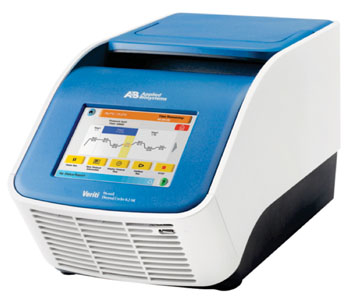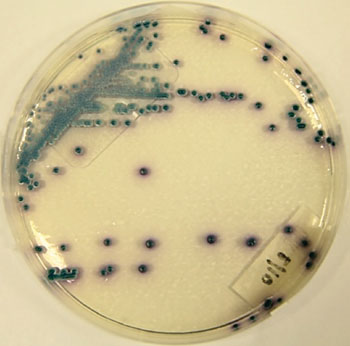Multiplex Nested PCR Detects Bloodstream Candida Species
|
By LabMedica International staff writers Posted on 14 Aug 2014 |

Image: The Veriti 96-Well Thermal Cycler for polymerase chain reactions (PCR) (Photo courtesy of Applied Biosystems).

Image: Candida tropicalis growing on specific CHROMagar culture media (Photo courtesy of Takamasa Kaneko).
A multiplex nested polymerase chain reaction (PCR) method has been developed to detect and identify seven Candida species in peripheral blood samples of critically ill pediatric patients.
Nosocomial candidaemia is associated with high mortality rates in critically ill pediatric and neonatal patients and therefore the early detection and identification of the infectious fungal agent is crucial for successful medical intervention.
Clinical microbiologists at the University of Sao Paulo (Butanta, Brazil) enrolled 54 consecutive pediatric patients, among whom there were 24 neonates, admitted to the intensive care unit (ICU) of two pediatric referral hospitals in Sao Paulo State (Brazil). The patients presented with systemic inflammatory response syndrome (SIRS) and at least two predisposing conditions/risk factors for the development of candidaemia. A control group included 28 children that had no evidence of any type of bloodstream infection and had undergone minor surgical procedures during the same time.
Blood samples were taken and either cultured or had DNA extracted. The 54 DNA samples were evaluated by multiplex nested PCR with specific primers designed to identify seven Candida species, and the results were compared with those obtained from blood cultures.
The extracted DNA samples were amplified and the reactions were carried out in a Veriti thermocycler (Applied Biosystems; Carlsbad, CA, USA). The nested PCR products were detected on 2.5% agarose gels and visualized under a UV transilluminator apparatus (UVITEC; Cambridge, UK).
The multiplex nested PCR had a detection limit of four Candida genomes/mL of blood for all Candida species. Blood cultures were positive in 14.8% of patients, whereas the multiplex nested PCR was positive in 24.0% of patients, including all culture-positive patients. The results obtained with the molecular technique were available within 24 hours, and the assay was able to identify Candida species with 100% of concordance with blood cultures. Additionally the multiplex nested PCR detected dual candidaemia in three patients. Candida albicans was the most frequently isolated species in blood cultures (five out of eight positive results), while the multiplex nested PCR identified C. albicans, C. parapsilosis complex, and C. tropicalis at similar frequencies.
The authors concluded that multiplex PCR assay targeting the intergenic space region (ITS) of Candida ribosomal DNA was able to identify the main Candida species involved in bloodstream pediatric infections with a detection limit of less than 10 colony forming units (CFU)/mL. The assay had high specificity, and is as least as sensitive as blood cultures but with a shorter turnaround time. The use of the multiplex nested PCR method also allowed the detection and identification of one or more Candida species in the same reaction. The study was published on July 21, 2014, in the journal BMC Infectious Diseases.
Related Links:
University of Sao Paulo
Applied Biosystems
UVITEC
Nosocomial candidaemia is associated with high mortality rates in critically ill pediatric and neonatal patients and therefore the early detection and identification of the infectious fungal agent is crucial for successful medical intervention.
Clinical microbiologists at the University of Sao Paulo (Butanta, Brazil) enrolled 54 consecutive pediatric patients, among whom there were 24 neonates, admitted to the intensive care unit (ICU) of two pediatric referral hospitals in Sao Paulo State (Brazil). The patients presented with systemic inflammatory response syndrome (SIRS) and at least two predisposing conditions/risk factors for the development of candidaemia. A control group included 28 children that had no evidence of any type of bloodstream infection and had undergone minor surgical procedures during the same time.
Blood samples were taken and either cultured or had DNA extracted. The 54 DNA samples were evaluated by multiplex nested PCR with specific primers designed to identify seven Candida species, and the results were compared with those obtained from blood cultures.
The extracted DNA samples were amplified and the reactions were carried out in a Veriti thermocycler (Applied Biosystems; Carlsbad, CA, USA). The nested PCR products were detected on 2.5% agarose gels and visualized under a UV transilluminator apparatus (UVITEC; Cambridge, UK).
The multiplex nested PCR had a detection limit of four Candida genomes/mL of blood for all Candida species. Blood cultures were positive in 14.8% of patients, whereas the multiplex nested PCR was positive in 24.0% of patients, including all culture-positive patients. The results obtained with the molecular technique were available within 24 hours, and the assay was able to identify Candida species with 100% of concordance with blood cultures. Additionally the multiplex nested PCR detected dual candidaemia in three patients. Candida albicans was the most frequently isolated species in blood cultures (five out of eight positive results), while the multiplex nested PCR identified C. albicans, C. parapsilosis complex, and C. tropicalis at similar frequencies.
The authors concluded that multiplex PCR assay targeting the intergenic space region (ITS) of Candida ribosomal DNA was able to identify the main Candida species involved in bloodstream pediatric infections with a detection limit of less than 10 colony forming units (CFU)/mL. The assay had high specificity, and is as least as sensitive as blood cultures but with a shorter turnaround time. The use of the multiplex nested PCR method also allowed the detection and identification of one or more Candida species in the same reaction. The study was published on July 21, 2014, in the journal BMC Infectious Diseases.
Related Links:
University of Sao Paulo
Applied Biosystems
UVITEC
Latest Microbiology News
- Handheld Device Deliver Low-Cost TB Results in Less Than One Hour
- New AI-Based Method Improves Diagnosis of Drug-Resistant Infections
- Breakthrough Diagnostic Technology Identifies Bacterial Infections with Almost 100% Accuracy within Three Hours
- Innovative ID/AST System to Help Diagnose Infectious Diseases and Combat AMR
- Gastrointestinal Panel Delivers Rapid Detection of Five Common Bacterial Pathogens for Outpatient Use
- Rapid PCR Testing in ICU Improves Antibiotic Stewardship
- Unique Genetic Signature Predicts Drug Resistance in Bacteria
- Unique Barcoding System Tracks Pneumonia-Causing Bacteria as They Infect Blood Stream
- Rapid Sepsis Diagnostic Test Demonstrates Improved Patient Care and Cost Savings in Hospital Application
- Rapid Diagnostic System to Detect Neonatal Sepsis Within Hours
- Novel Test to Diagnose Bacterial Pneumonia Directly from Whole Blood
- Interferon-γ Release Assay Effective in Patients with COPD Complicated with Pulmonary Tuberculosis
- New Point of Care Tests to Help Reduce Overuse of Antibiotics
- 30-Minute Sepsis Test Differentiates Bacterial Infections, Viral Infections, and Noninfectious Disease
- CRISPR-TB Blood Test to Enable Early Disease Diagnosis and Public Screening
- Syndromic Panel Provides Fast Answers for Outpatient Diagnosis of Gastrointestinal Conditions
Channels
Clinical Chemistry
view channel
Carbon Nanotubes Help Build Highly Accurate Sensors for Continuous Health Monitoring
Current sensors can measure various health indicators, such as blood glucose levels, in the body. However, there is a need to develop more accurate and sensitive sensor materials that can detect lower... Read more
Paper-Based Device Boosts HIV Test Accuracy from Dried Blood Samples
In regions where access to clinics for routine blood tests presents financial and logistical obstacles, HIV patients are increasingly able to collect and send a drop of blood using paper-based devices... Read moreMolecular Diagnostics
view channel
RNA-Based Blood Test Detects Preeclampsia Risk Months Before Symptoms
Preeclampsia remains a major cause of maternal morbidity and mortality, as well as preterm births. Despite current guidelines that aim to identify pregnant women at increased risk of preeclampsia using... Read more
First Of Its Kind Test Uses microRNAs to Predict Toxicity from Cancer Therapy
Many men with early-stage prostate cancer receive stereotactic body radiotherapy (SBRT), a highly precise form of radiation treatment that is completed in just five sessions. Compared to traditional radiation,... Read moreNovel Cell-Based Assay Provides Sensitive and Specific Autoantibody Detection in Demyelination
Anti-myelin-associated glycoprotein (MAG) antibodies serve as markers for an autoimmune demyelinating disorder that affects the peripheral nervous system, leading to sensory impairment. Anti-MAG-IgM antibodies... Read moreHematology
view channel
New Scoring System Predicts Risk of Developing Cancer from Common Blood Disorder
Clonal cytopenia of undetermined significance (CCUS) is a blood disorder commonly found in older adults, characterized by mutations in blood cells and a low blood count, but without any obvious cause or... Read more
Non-Invasive Prenatal Test for Fetal RhD Status Demonstrates 100% Accuracy
In the United States, approximately 15% of pregnant individuals are RhD-negative. However, in about 40% of these cases, the fetus is also RhD-negative, making the administration of RhoGAM unnecessary.... Read moreImmunology
view channel
Stem Cell Test Predicts Treatment Outcome for Patients with Platinum-Resistant Ovarian Cancer
Epithelial ovarian cancer frequently responds to chemotherapy initially, but eventually, the tumor develops resistance to the therapy, leading to regrowth. This resistance is partially due to the activation... Read more
Machine Learning-Enabled Blood Test Predicts Immunotherapy Response in Lymphoma Patients
Chimeric antigen receptor (CAR) T-cell therapy has emerged as one of the most promising recent developments in the treatment of blood cancers. However, over half of non-Hodgkin lymphoma (NHL) patients... Read morePathology
view channel
Advanced Imaging Reveals Mechanisms Causing Autoimmune Disease
Myasthenia gravis, an autoimmune disease, leads to muscle weakness that can affect a range of muscles, including those needed for basic actions like blinking, smiling, or moving. Researchers have long... Read more
AI Model Effectively Predicts Patient Outcomes in Common Lung Cancer Type
Lung adenocarcinoma, the most common form of non-small cell lung cancer (NSCLC), typically adopts one of six distinct growth patterns, often combining multiple patterns within a single tumor.... Read moreTechnology
view channel
Pain-On-A-Chip Microfluidic Device Determines Types of Chronic Pain from Blood Samples
Chronic pain is a widespread condition that remains difficult to manage, and existing clinical methods for its treatment rely largely on self-reporting, which can be subjective and especially problematic... Read more
Innovative, Label-Free Ratiometric Fluorosensor Enables More Sensitive Viral RNA Detection
Viruses present a major global health risk, as demonstrated by recent pandemics, making early detection and identification essential for preventing new outbreaks. While traditional detection methods are... Read moreIndustry
view channel
Cepheid and Oxford Nanopore Technologies Partner on Advancing Automated Sequencing-Based Solutions
Cepheid (Sunnyvale, CA, USA), a leading molecular diagnostics company, and Oxford Nanopore Technologies (Oxford, UK), the company behind a new generation of sequencing-based molecular analysis technologies,... Read more
Grifols and Tecan’s IBL Collaborate on Advanced Biomarker Panels
Grifols (Barcelona, Spain), one of the world’s leading producers of plasma-derived medicines and innovative diagnostic solutions, is expanding its offer in clinical diagnostics through a strategic partnership... Read more























